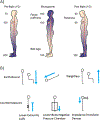Gravitational Influence on Intraocular Pressure: Implications for Spaceflight and Disease
- PMID: 31162175
- PMCID: PMC6786882
- DOI: 10.1097/IJG.0000000000001293
Gravitational Influence on Intraocular Pressure: Implications for Spaceflight and Disease
Abstract
Spaceflight-associated neuro-ocular syndrome (SANS) describes a series of morphologic and functional ocular changes in astronauts first reported by Mader and colleagues in 2011. SANS is currently clinically defined by the development of optic disc edema during prolonged exposure to the weightless (microgravity) environment, which currently occurs on International Space Station (ISS). However, as improvements in our understanding of the ocular changes emerge, the definition of SANS is expected to evolve. Other ocular SANS signs that arise during and after ISS missions include hyperopic shifts, globe flattening, choroidal/retinal folds, and cotton wool spots. Over the last 10 years, ~1 in 3 astronauts flying long-duration ISS missions have presented with ≥1 of these ocular findings. Commensurate with research that combines disparate specialties (vision biology and spaceflight medicine), lessons from SANS investigations may also yield insight into ground-based ocular disorders, such as glaucomatous optic neuropathy that may have the potential to lessen the burden of this irreversible cause of vision loss on Earth.
Figures




Comment in
-
Optic Disc Swelling in Astronauts: A Manifestation of "Glymphedema"?J Glaucoma. 2019 Nov;28(11):e166-e167. doi: 10.1097/IJG.0000000000001349. J Glaucoma. 2019. PMID: 31425337 No abstract available.
-
In Reply: Optic Disc Swelling in Astronauts: A Manifestation of "Glymphedema"?J Glaucoma. 2019 Nov;28(11):e167-e169. doi: 10.1097/IJG.0000000000001350. J Glaucoma. 2019. PMID: 31425338 Free PMC article. No abstract available.
References
-
- Stenger MB, Tarver WJ, Brunstetter T, et al. NASA Human Research Program Evidence Report: Risk of Spaceflight Associated Neuro-Ocular Syndrome (SANS). NASA Johnson Space Center; 2017. https://humanresearchroadmap.nasa.gov/evidence/reports/SANS.pdf?rnd=0.43.... Accessed February 15, 2018.
Publication types
MeSH terms
Grants and funding
LinkOut - more resources
Full Text Sources

